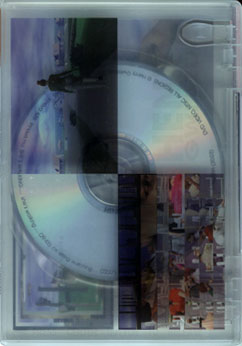
Henry Gwiazda wants us to take notice of small, beautiful, everyday occurrences. To this end, he's produced a DVD of computer animations and sounds designed to draw attention to those easily overlooked movements, human actions or natural events, that tend to drift beneath one's consciousness and get lost among more "important" happenings. As revealed in the accompanying interview by Kyle Gann (clumsily handled by Gann but gracefully countered by Gwiazda), he realized that the full screen animation would often be received with confusion by viewers, unsure what they were supposed to be catching. The actions Gwiazda (silent i, by the way) wanted to focus on were too readily missed, despite the fact they might be the only elements not in stop-motion at the given time. His solution was to present each episode twice. First, the screen is divided into quarters, the "camera angle" centered on four different areas, from varying angles and depths. After the scene plays through once in this manner, it's viewed again in its entirety from a single vantage, the viewer, the material already nested in his/her subconscious, much more able to register awareness of the subtle goings on.
The style of animation looks, in a sense, like a generic computer brand (think Max Headroom) which put me off a bit at first. The human figures have a manikin-like aspect and oddly articulated movement that takes some getting used to. Similarly, the backgrounds are both realistic and abstracted, often flattened out into variously colored fields. Within that, however, there's some remarkable realism especially as involves effects of light. Gwiazda presents three vignettes, each taking place in a well-off suburban neighborhood of large houses, running trails, pleasant outdoor cafes and nearby beaches. It's an interesting choice, not selecting a more...hip environment; I like the notion. One assumes it's more or less based on his own living situation as Gwiazda himself seems to appear several times, once practicing electric guitar. His "characters" go through daily routines, washing up, eating, going for walks, practicing golf swings, eating some more, etc. By choosing these blandest of activities, he allows us to concentrate on the enormous range of lovely "small" things constantly occurring. A given scene might consist of ten or twelve principal elements but most will be frozen in time at any given moment with only one or two in motion. A hand moving toward a coffee cup, a strand of hair blowing in the breeze, the sunlight playing across the backs of outdoor chairs. Sometimes, as in "I'm Sitting, Watching", the work here that takes place in an outdoor café, it's very much like observing an extremely spare, tightly controlled dance troupe, each tiny gesture maximized for aesthetic effect. When, as happens on occasion, these sequences cascade from one actor to another, it's quite magical. I was drawn ineluctably, ever more fascinated by the amount of unexpectedly beautiful detail and the relationships between them. The soundtrack, as it were, consists of field recordings of similar everyday activity though their placement generally has little to do with what's transpiring on screen. A door will be opened, for instance, and you might here the sound of a car engine; people talk and you hear crumpled paper or water poured into a glass. Near the conclusion of each piece comes a spoken epigram. The first advises, "Perhaps every day is about the same because we need the time to practice what to see and what to hear."
"She's Walking..." is a profound, acute observation on "those empty spots, those times in between". Highly recommended. Further insight into this composer can be found at his website, www.henrygwiazda.com.
Comments and Feedback:



More Recent Reviews, Articles, and Interviews @ The Squid's Ear...


|

